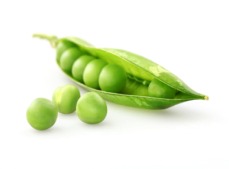Peas

Wild peas have been traced back nearly 7000 years to the Nile Delta region. The pea is a cool season annual legume now grown in most cool temperate regions. Legumes are important crops in agriculture and horticulture because of their symbiosis with N-fixing bacteria; raising soil nitrogen without recourse to nitrogen fertilisers. This makes them more environmentally friendly than cereals and most other food crops.
Originally, peas were always harvested fully senesced and dry. They were usually crushed or ground as part of a soup or meal, like other pulses. During the 18th century in England the pea was hybridised to resemble more or less what we grow today. It then became fashionable to harvest the pea whilst still green and to serve it as a green vegetable (strictly speaking, the pea pod is a fruit and the peas within are seeds). At first, this was scoffed at by our neighbours, but is now the most common practice. Frozen peas are probably the freshest vegetables available, short of growing your own, because they are harvested and frozen within hours. As with all produce, the final quality depends upon the soil in which they are grown but peas also have unique, recently discovered, benefits to health. Apart from containing a wide range of minerals and vitamins and being low in fat and cholesterol, they contain important phytonutrients (pronounced “fight-o-nutrients”). These are natural, bioactive compounds found in fruits and vegetables that work together with vitamins, minerals, and fibre to promote good health. One of these, coumestrol, reduces the risk of stomach cancer and others reduce the risk of Type 2 diabetes.
The Dressing Process
Field Science tailored mineral dressings are always based on detailed soil analysis of the field to be treated. A member of our technical team will visit your farm to discuss and identify where we can help. Soil samples are then taken and the tailored dressings are based on the independent laboratory’s results.
The Single Crop Dressing is the best option for peas as the soil is usually ploughed after harvest and that would effectively bury a multi-year dressing out of reach of the roots.
The best time for application is just after emergence and the application rate is usually 25kg per hectare (10kg/ac) and the most effective method of application is to use an electric spinner (slug-pelleter) on a quad bike. The dressings are packed in 25kg bags, clearly labelled with the farm details, field name, application rate and bag weight.
